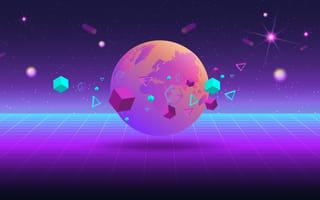The metaverse is a term that refers to a future iteration of the internet that includes persistent, immersive virtual worlds where people can connect with friends, work, play games and shop. You can think of the metaverse as a cyberspace, or an evolved, three-dimensional internet where logging in isn’t necessary. It may also incorporate elements of virtual and augmented reality.
Metaverse Meaning
At the moment, the idea of one true metaverse is still hypothetical. But that hasn’t stopped some tech giants from building metaverse-like experiences, such as virtual fashion shows, live concerts and workspaces.
What Is the Metaverse?
In his book The Metaverse: And How It Will Revolutionize Everything, author and investor Matthew Ball offers this comprehensive definition of the metaverse:
“A massively scaled and interoperable network of real-time rendered 3D virtual worlds that can be experienced synchronously and persistently by an effectively unlimited number of users with an individual sense of presence, and with continuity of data, such as identity, history, entitlements, objects, communications, and payments.”
Here’s a closer look at each of these elements that Ball says make up the metaverse:
- Virtual worlds: Computer-generated environments.
- Three-dimensional: Without 3D capabilities, the metaverse would just be the internet.
- Real-time rendered: Virtual worlds that can “respond to input from a user.”
- Massively scaled: As big and diverse as the real world.
- Interoperable network: A standardized set of protocols between various platforms that allow users to “carry” personal information from one virtual world to another.
- Persistence: It’s always on and accessible to users.
- Synchronous: People can share simultaneous experiences in real time.
- Unlimited users and individual presence: Lets millions of users on at the same time, each with control over their own point of view, perhaps through an avatar.
Ball conceives of the metaverse not as something wholly separate from the internet, but an evolution of it — an embodied internet you are within, rather than have access to.
“The metaverse will not replace or fundamentally alter the internet’s underlying architecture or protocol suite,” Ball wrote in The Metaverse. “Instead, it will evolve to build on top of it in a way that will feel distinctive.”
The similarities between the metaverse and the internet don’t stop there: “The way the metaverse looks is very similar to how the internet emerged,” Pim de Witte, co-founder and chief executive officer of Medal, a game-clip-sharing platform, told Built In.
De Witte conceives of the metaverse not as a single destination that everyone defaults to, but as a complex network consisting of browsers, indexes and destinations.
He explained it like this: Platforms such as Fortnite, Roblox and Minecraft are not in themselves metaverses, but destinations within the metaverse. There will be lots of these sorts of destinations, not unlike individual websites on the internet today. In other words, Fortnite is not a metaverse, in the same way that Facebook is not an internet. The two are both planets within a larger galaxy.
History of the Metaverse
The term ‘metaverse’ first appeared in author Neal Stephenson’s 1992 science-fiction novel Snowcrash, which describes a future where millions of people use virtual avatars to participate in a cyberspace realm. This concept was further popularized in another sci-fi novel, Earnest Cline’s 2011 Ready Player One, in which everyday people strap on VR headsets and log into a virtual world to live out their fantasies.
Glimpses of the metaverse can be spotted in various games and platforms that popped up in the 21st century, including Second Life, Fortnite, Roblox, Minecraft, Sandbox and Decentraland.
In 2021, Facebook rebranded to Meta, catapulting the idea of the metaverse into the larger public consciousness.
“The next platform will be even more immersive — an embodied internet where you’re in the experience, not just looking at it,” Zuckerberg wrote in an open letter explaining his company’s pivot. “We call this the metaverse, and it will touch every product we build.”
How the future will shake out is far from known, but it may involve all of the previously mentioned platforms connected together in some larger metaverse.
Metaverse Examples
Second Life
In 2003, the company Linden Lab launched Second Life. It’s not quite a game — there are no points or overarching objectives — but a simulated 3D environment where users can do practically anything. They can adopt new personas, cultivate hobbies, run businesses and create friendships with people from far-flung geographies.
Second Life proved to be a massive hit upon release, with around a million users signing up. Harvard University held classes in it, rapper Jay-Z threw a concert in it and Rolling Stone called it “the future of the Net.” Eventually, though, enthusiasm for Second Life waned, and the platform’s growth flattened. Still, its cultural impact signaled the possibility of a metaverse.
Roblox
Roblox, a sandbox-like virtual platform where people can build and play games and experiences, was launched in 2006 — although it took more than a decade for it to become a mainstream success. By January 2022, Roblox had nearly 55 million daily active users, and Roblox Corporation CEO David Baszucki called his company “shepherds of the metaverse.”
Fortnite
Fortnite, the battle-royale-style action game published by Epic Games, sprang to notoriety in 2019. Functionally a virtual hub for social connection and attending live events, Fornite spans multiple platforms, including PC, mobile and several game consoles, offering an unforeseen degree of interoperability to users despite being in an industry that historically prefers to operate inside walled gardens. That interoperability, along with the way it allows wildly diverse IP to coexist in its game — you might see Iron Man fighting alongside Indiana Jones and LeBron James, for instance — is why Fortnite offers a glimpse into the possibilities of the metaverse.
How Does the Metaverse Work?
In theory, the metaverse works by allowing an infinite number of people to synchronously connect together in real time in an always-on virtual environment that’s immersive, three-dimensional and connects to our physical world in seamless ways.
In reality, it’s a tricky technological feat to accomplish. Such a thing requires enormous amounts of computer processing and advancements made in smartphone, gaming device and VR and AR headset technology.
Plus, a single, interoperable metaverse — one that would let users carry their identities and digital collectibles across platforms owned by different companies — would require serious coordination and cooperation between various organizations.
Historically, companies (gaming companies especially) have been hesitant to allow their assets to be compatible with a competitor’s ecosystem. Playing nicely with other platforms, the logic goes, would mean giving up some amount of control. But for a fully realized metaverse to come about, such cooperation will be necessary.
How to Access the Metaverse
For now, there is no one entrance or gateway into the metaverse, because the idea of a single metaverse is still theoretical. That said, people who want to participate in metaverse-like experiences have a number of options:
- Buy a virtual reality headset and join a social VR experience like Horizon Worlds, VRChat or Rec Room.
- Create a free account on a platform like Roblox, Fortnite or Minecraft, which you can experience on a PC, mobile device or gaming console.
- Check out ethereum-based virtual worlds like The Sandbox and Decentraland.
In the future, there may be a main hub that connects users to each part of the metaverse, like the forest in The Nightmare Before Christmas, with magical doors that allow anyone to move seamlessly in and out of discrete worlds.
Who Owns the Metaverse?
Just like no one entity “owns” the internet, it’s doubtful that anyone, be it a government organization or multinational corporation, will have sole ownership of the metaverse. Rather, the metaverse will likely emerge with a constellation of companies, collectives and independent developers operating under some agreed-upon policies and protocols.
The Khronos Group is one organization trying to make that happen. OpenXR, Khronos Group’s royalty-free standard VR and AR developers use to create cross-platform experiences, has already gained widespread industry support and demonstrated the benefits of interoperability. So there’s hope that the group’s latest project, the Metaverse Standards Forum, a community made up of more than 1800 standards organizations, nonprofits and companies, will devise and promote ways to build an inclusive and pervasive metaverse.
And that certainly beats the alternative, according to Epic Games CEO Tim Sweeney.
“This metaverse is going to be far more pervasive and powerful than anything else,” Sweeney told VentureBeat. “If one central company gains control of this, they will become more powerful than any government and be a god on Earth.”
The Metaverse Economy
Fortnite is free to play, and yet the game still brings in billions of dollars in revenue. That’s because users are eager to pay for costumes, dance moves and character accessories that serve aesthetic and expressive purposes (rather than, say, give players a competitive edge).
The metaverse’s economy will not just consist of companies selling digital goods to users. It will also, perhaps primarily, consist of peers selling to peers. Take Roblox as an example. On the platform, users have the ability to create their own games using Roblox’s developer tools. They can then monetize their creations by selling them to other users. If they cash out, Roblox takes a cut.
For the most part, “It’s a free-market, user-driven economy,” Deepak Chandrasekaran, Roblox vice president of product management, said. And it’s “not just about taking money out of the ecosystem, it’s also about using the same virtual currency and spending it across the ecosystem.”
Roblox users don’t just show up on the platform, sell something, take their money and leave. Most of them put that money back into the platform’s economy, by spending it on games or avatar customizations that other users create. Money travels in and around, rather than out. It’s a growing, self-sufficient economy.
“We actually have to pretty much simulate the entire real world. The only thing I think we don’t have is stocks,” Chandrasekaran said. “But ... I think it’s inevitable that we may end up there.”
Frequently Asked Questions
What is the metaverse?
The metaverse is a hypothetical future version of the internet made up of persistent, 3D virtual worlds that converge real life with augmented reality and virtual reality.
How do I enter the metaverse?
Since the metaverse is a hypothetical concept, there is no way to enter it. But you can enjoy metaverse-like experiences by joining Roblox or Fortnite, among other platforms.
What is the point of the metaverse?
The metaverse offers people a chance for to connect socially, shop, work and play in a 3D virtual world that spans platforms and isn’t subject to all the limitations of the physical world.
Who owns the metaverse?
No single entity owns the metaverse, but several companies invested in creating metaverse-like experiences include Meta, Roblox, Epic Games, Google, Microsoft and Unity Technologies, among others.
What’s the difference between the metaverse and Web3?
While both the metaverse and Web3 cast a vision of the next-generation version of the internet, they are not identical concepts and the terms shouldn’t be used interchangeably. Web3 is a term used to describe a decentralized internet built on a blockchain foundation, while the metaverse simply describes a future version of the internet, which may or may not include the characteristics of Web3.







